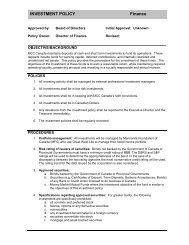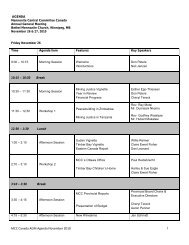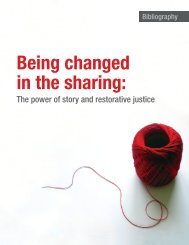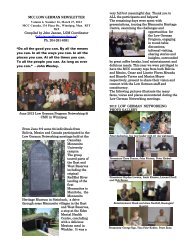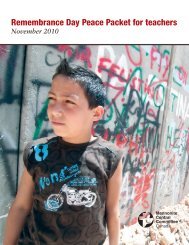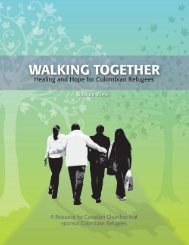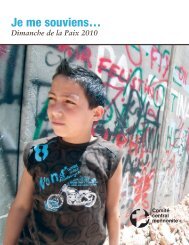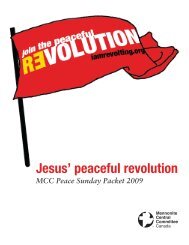to download PDF - Mennonite Central Committee Canada
to download PDF - Mennonite Central Committee Canada
to download PDF - Mennonite Central Committee Canada
You also want an ePaper? Increase the reach of your titles
YUMPU automatically turns print PDFs into web optimized ePapers that Google loves.
Vietnam WarDraft Resisterthe s<strong>to</strong>ry of SamSteinerThirty-eight years ago I was a new political refugeein <strong>Canada</strong>. On November 2, 1968 I obtainedlanded-immigrant status at the border crossingbetween Port Huron, Michigan and Sarnia,Ontario. Three days earlier, I had been indicted bya grand jury in the U.S. District Court inCleveland, Ohio, for failing <strong>to</strong> comply with anorder <strong>to</strong> report for and submit <strong>to</strong> induction in<strong>to</strong>the armed forces of the United States.How does a mild-mannered twenty-one year oldfuture librarian with an impeccable <strong>Mennonite</strong>pedigree get himself in<strong>to</strong> a mess like this?Christian faith as expressed by <strong>Mennonite</strong>s—withits implications for all of life—was central <strong>to</strong> myfamily of origin. My great-great grandfather, PeterSteiner, was also something of draft resister <strong>to</strong> militaryservice. Family lore says he escaped fromNapoleon’s army on its way <strong>to</strong> Russia and eventuallyfound his way <strong>to</strong> North America.The small church of that I attended in the 1950scared much about love and mutual aid within thecommunity. It cared about the eternal destiny ofthose within its midst and unsaved souls on variousmission fields. But it seemed <strong>to</strong> care less about justicein the society around it. We prayed for peace.We wished for justice <strong>to</strong> go with that peace but wedidn’t “fight” for justice.I attended Goshen College, a <strong>Mennonite</strong> school innorthern Indiana, in 1964 with an undevelopedsense of how Christian faith might constructivelywork within the larger secular Society. In highschool I had shifted from naïve faith <strong>to</strong> become theclass atheist. I also went <strong>to</strong> university as a patrioticracial bigot. Like all 18-year old American males, Ihad <strong>to</strong> register for the military draft on my birthday.I did so, but I did not register as a conscientiousobjec<strong>to</strong>r <strong>to</strong> war as most <strong>Mennonite</strong> youngmen would have done.However, six months after I registered for the militarydraft I underwent a political, if not spiritual,conversion. With a carload of other GoshenCollege students I planned <strong>to</strong> be a passive observerof a large civil rights march taking place betweenSelma and Montgomery, Alabama, led by CivilRights leader Martin Luther King. On that ridein<strong>to</strong> Alabama I finally became emotionally connected<strong>to</strong> the visible injustice that has always beenaround me. For the first time I experienced internallythe underside of the American way of life.During that ride through Alabama, our carload ofuniversity students, one of whom was MiddleEastern, also saw hatred and distrust in the whiteeyes around us.When I returned <strong>to</strong> college I recognized I could notkill another human being on the basis of political(or economic) differences. I also saw the need <strong>to</strong>combine social justice with my newfound (or rediscovered)pacifism. Belatedly I registered with mydraft board as a conscientious objec<strong>to</strong>r. I arguedthat life was inherently sacred, and that I did nothave the right—ever—<strong>to</strong> terminate another humanlife. I recognized I did not have the wisdom <strong>to</strong>make that kind of decision.The political conversion I had experienced led <strong>to</strong>an activist phase in my life. I joined radical studen<strong>to</strong>rganizations and participated in mass demonstrations.Gradually I became more involved in thedraft resistance movement that grew along with theVietnam War.Eventually I destroyed my draft card, which allAmerican men were legally required <strong>to</strong> carry, and Imailed the pieces back <strong>to</strong> the government informingthem I would no longer participate in themilitary system. Among other things in my letter <strong>to</strong>the government, I questioned the use of death as atechnique for conflict resolution. I also questionedthe alternative service system, lovingly embraced by<strong>Mennonite</strong>s for decades. I believed “alternativeservice” simply helped the U.S. military system <strong>to</strong>work efficiently as <strong>Mennonite</strong>s and other pacifistsperformed meaningless service that aided the“national welfare.” This led <strong>to</strong> the loss of my job.For one stretch I lived on Kraft dinners purchasedwith funds from the sale of my blood.I worked for some months as a supply clerk at ahospital in Illinois. Many of my co-workers were<strong>Mennonite</strong> young men who were putting in twoyears of “alternative service.” That was government-approvedcivilian service in lieu of militaryservice. Throughout the Vietnam war it remainedrelatively easy for young men from peace churcheslike the <strong>Mennonite</strong>s and Quakers <strong>to</strong> avoid militaryservice if they stuck <strong>to</strong> the rules. For a young<strong>Mennonite</strong> this often meant having your pas<strong>to</strong>rhelp fill out the relevant forms with the appropriate43



